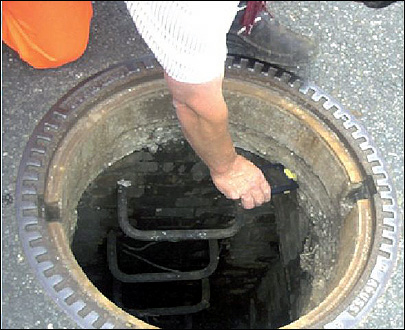The city of Warendorf, in Germany’s most populous state, North Rhine Westphalia, is using approximately 5,500 RFID tags to track the maintenance of its 205-kilometer (127-mile) network of sewage canals and pipes.
The system has improved the city’s ability to comply with laws mandating that sewage canals be checked on a regular basis. The use of RFID technology enables an up-to-date overview of those canals that have been monitored, and those remaining unchecked. This allows workers to document their activities without pen and paper, avoiding typos and dirty smudges. In addition, it also reduces the number of pipe-identification errors made by workers confused by the layout of pipes at some intersections.
The city had initially considered a bar-code system, but shied away from that because of the dirty work environment that would entail—dirt can obscure a bar-coded label and make it unreadable. Eventually, the government decided on an RFID-based solution conceived by Bernhard Amsbeck, a local company that builds parts for canals. Implemented by Tec-Tus Transponder Technology, based in the city of Moers, the system works in conjunction with the city’s existing geographic information system from Softplan Informatik, implemented in 2001.
After opening a manhole and confirming that a pipe is neither clogged nor infested with rodents, a worker stoops over the manhole and uses a handheld combination reader-computer to interrogate the pipe’s passive 125 KHz RFID tag. Made by Tec-Tus, each tag is embedded in a yellow polyamide capsule to protect it. The project utilizes only two readers, provided by Intermec and shared among the workers.
A single worker can read several hundred pipes per day. The readers use Windows CE software and a custom application designed by Tec-Tus. The project team first tested an interrogator from Psion Teklogix, but switched to the Intermec interrogator-computer because the application needed additional storage space, according to Tobias Greve, an IT specialist with the city’s waste-management department.
After each interrogation, the employee uses a stylus to key into the handheld the status of the pipe and any work done (such as laying poison for rats or cleaning out debris). Specially designed software allows workers to click on a standardized abbreviation for the work performed; the computer saves the information, linking the pipe’s ID with work orders or maintenance status. Workers are now able to maintain an overview of work orders without carrying thick folders of paper.
The city had the option of designing and implementing a system able to read RFID tags without requiring workers to remove the 5,500 manholes in the network. However, it opted instead to place the tag inside the mouth of the pipe, on the edge, so workers would have to follow through on a visual inspection by opening the manhole.
At this point, city employees can also key in a confirmation that work contracted to third parties was actually carried out. In the past, Greve explains, outside companies have billed the city for cleaning pipes they did not actually clean. When personnel return to the office, the system transfers information from the reader into the city’s maintenance database. For this process, the worker places the handheld in a docking station and the system synchronizes the files.
The system began running in March 2003, after the city spent about three months tagging pipes. The biggest hurdle to setting up the application was updating the city’s maintenance database, Greve says, since many maintenance records only existed in paper form. It took about two years to complete that process.
A city spokesperson declines to provide any concrete ROI figures, saying only that investment in the system “paid off quickly.” Warendorf’s leadership was so pleased with the application that, soon after the pipe-maintenance system was running smoothly, the city chose to expand the system to monitor the maintenance of 1,500 valves at a sewage plant.



